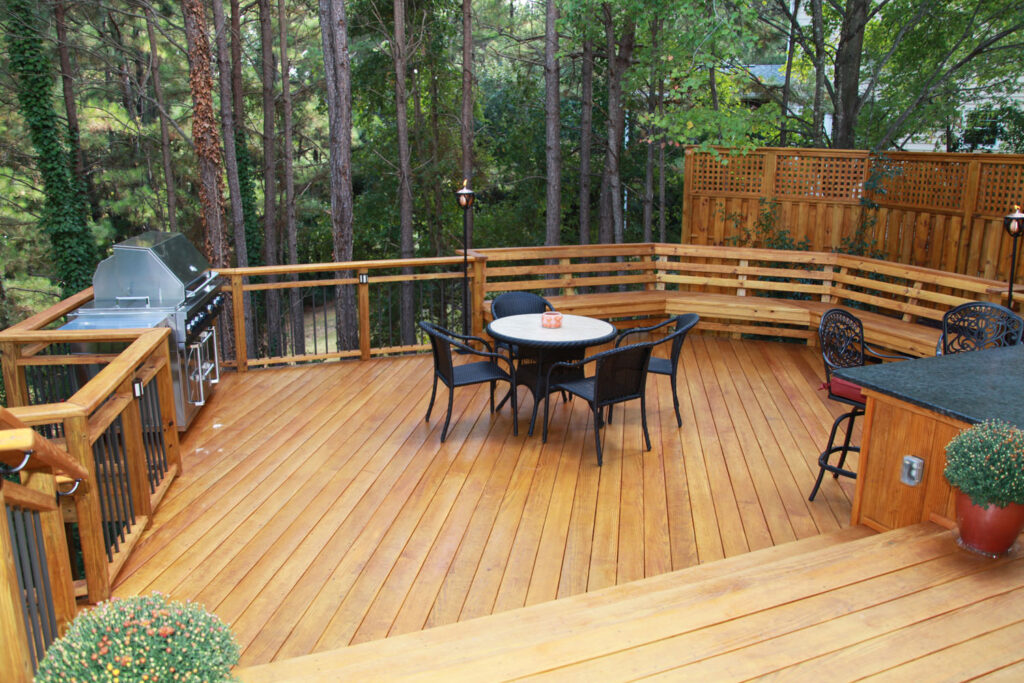असली लकड़ी बनाम समग्र या प्लास्टिक अलंकार
असली लकड़ी बनाम
समग्र अलंकार
जबकि कुछ घर के मालिक और बिल्डर समग्र या प्लास्टिक अलंकार का विकल्प चुनते हैं, दबाव-उपचारित दक्षिणी पाइन अभी भी कई कारणों से सबसे लोकप्रिय विकल्प है।
सौंदर्य, अतिरिक्त मूल्य, और आराम कुछ कारण हैं कि दक्षिणी पाइन डेक और पोर्च इतने लोकप्रिय क्यों हैं, इन “आउटडोर कमरे” का उल्लेख नहीं करने के लिए खुली हवा में मनोरंजन और विश्राम के लिए घर के रहने की जगह का विस्तार करते हैं।
लेकिन डेक की चलने वाली सतह के अलंकार बोर्डों में एक कठिन काम है। अलंकार मौसम और पैदल यातायात से कठोर दिन-प्रतिदिन की सजा लेता है, और डेक के सबसे दृश्यमान भाग के रूप में, उन्हें उच्च दीर्घकालिक फिट, फिनिश और उपस्थिति अपेक्षाओं को पूरा करना होगा।
बाहरी परियोजनाओं के लिए लकड़ी सबसे अच्छा पर्यावरणीय विकल्प है
, क्योंकि अन्य अलंकार उत्पादों को लकड़ी की तुलना में उत्पादन करने के लिए आठ गुना अधिक ऊर्जा की आवश्यकता हो सकती है।
ठोस लकड़ी एक स्वाभाविक रूप से उगाया जाने वाला और नवीकरणीय उत्पाद है, कंपोजिट के विपरीत जो आमतौर पर पेट्रोलियम आधारित सामग्री जैसे पॉलीथीन, पॉलीप्रोपाइलीन, पॉलीस्टाइनिन, या पॉलीविनाइल क्लोराइड से बने होते हैं।
यदि आप दक्षिणी पाइन अलंकार या प्लास्टिक/समग्र विकल्प के बीच निर्णय लेने के लिए तैयार हैं, तो निम्नलिखित पर विचार करें:
- सौंदर्यविषयक
- क़ीमत
- टिकाऊपन
- पर्यावरणीय प्रभाव
- दीर्घ आयु
- अनुरक्षण
अंततः, लकड़ी और समग्र अलंकार के बीच का चुनाव आपकी प्राथमिकताओं और प्राथमिकताओं पर निर्भर करता है। यदि आप एक प्राकृतिक सौंदर्य को महत्व देते हैं और रखरखाव में समय लगाने के इच्छुक हैं, तो लकड़ी का अलंकार सही विकल्प हो सकता है।

| Question | Real Wood | Composites or Plastics | What are the facts? |
|---|---|---|---|
| Natural Appearance? | Yes | No | There is no substitute for the look and feel of real wood. Wood decking looks warm, natural, and blends beautifully with the landscape. Plastic or plastic composites, even with faux wood grain, still look and feel artificial. |
| Comfortable under foot? | Yes | ? | Wood is a naturally insulating material and does not conduct heat or cold like metal or plastic. In direct sun, some plastic or composite decking can become much hotter than wood, hot enough to burn or blister feet. |
| Safe to use? | Yes | Yes | Pressure-treated wood is safe for people, pets, and the environment. Furthermore, advanced preservative formulations contain no arsenical or chromium compounds while being resistant to decay and termite attack. |
| Renewable? | Yes | No | Wood is the only building material that uses the sun’s energy to renew itself in a continuous cycle. Sustainable forestry practices ensure our supply of homegrown wood will be maintained for future generations. On the other hand, plastics are derived from finite petroleum resources. |
| Earth-friendly? | Yes | No | Manufacturing wood products uses less energy and produces less air and water pollution than other building materials. Manufacturing plastic decking requires more energy to produce than a comparable piece of wood decking. |
| Strong? | Yes | No | Wood can be up to four times stronger than plastic or composite products and possesses up to nine times the stiffness of artificial decking. Wood decking is not affected by heat, which tends to promote creep (sagging) in composites over time. |
| Needs maintenance? | Yes | Yes | Despite claims to the contrary, all decking requires maintenance. Periodic cleaning and application of a water-repellant sealer is all that is needed to keep a wood deck in top shape. A good scrubbing usually removes most stains on wood decking, too. |
| Decay/termite warranty? | Lifetime limited | Limited | Wood preservative manufacturers typically offer a limited lifetime warranty against decay and termite attack in residential use. Plastic or composite deck manufacturers typically offer a limited warranty. |
| Standardized product? | Yes | No | Approved inspection agencies monitor lumber production and pressure-treating facilities. These agencies operate under rigorous protocols to enforce uniform performance and quality standards approved by the American Lumber Standard Committee and/or the American Wood Protection Association. |